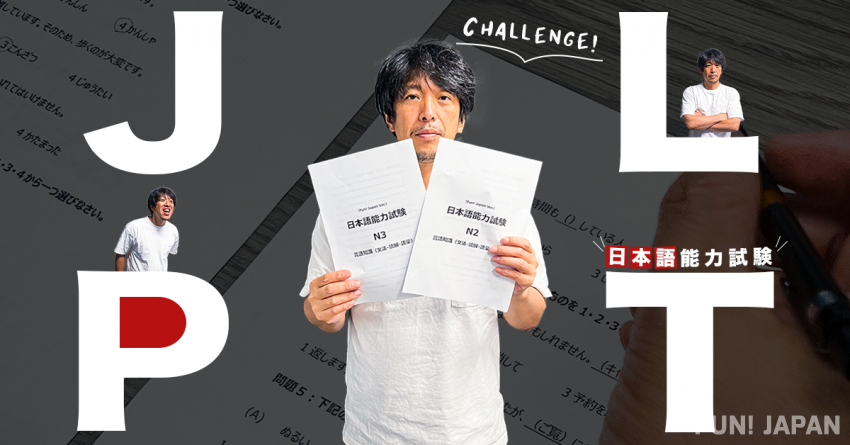
――JAPANESE-LANGUAGE PROFICIENCY TEST (日本語能力試験 / Nihongo Noryoku Shiken - abbreviated as "JLPT").
If you are studying Japanese, probably there will be no one who does not know this name. It is a test to measure and certify Japanese language proficiency for people whose native language is not Japanese, held in countries around the world, including many English speaking countries, every July and December.
Are exams that many Japanese learners find difficult, also difficult in the eye of native-speaking Japanese? In order to verify this, we decided to ask Rannyu Sensei, who also teaches Japanese in the FUN! Japan newsletters, to challenge the problems of the same difficulty level as the JLPT from the Japanese learning content. And Sensei's impression after solving the JLPT sample questions is...?
What is JAPANESE-LANGUAGE PROFICIENCY TEST (JLPT)?

For those of you who have never heard of the name of the JLPT test, or for those who are new to learning Japanese, let us explain the basics of such test.
The JAPANESE-LANGUAGE PROFICIENCY TEST (JLPT) has five levels, N1, N2, N3, N4, and N5, and multiple-choice questions are created for each level. It consists of three elements: "Language Knowledge" (Vocabulary/Grammar), which measures knowledge of Japanese characters, vocabulary, and grammar, along with "Reading", and "Listening". The easiest level is N5, while the most difficult level is N1.
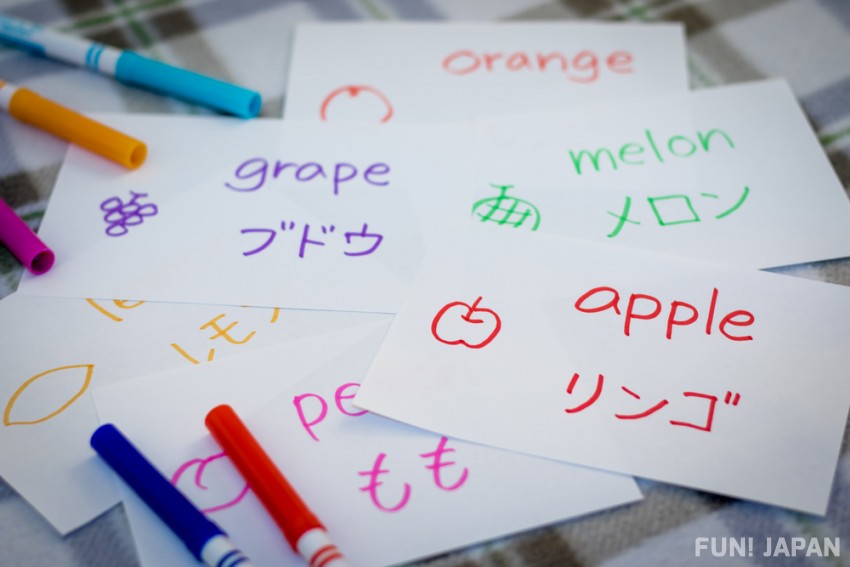
Looking at the data of the 2nd test in 2021 (December) announced by the Japan Foundation and Japan Educational Exchanges and Services, the percentage certified for N5 in Japan and overseas is 62.3%, while that for N1 is only 34.5%. Although the percentage certified for both N1 and N2 remains at around 40%, many Japanese companies require Japanese language proficiency of N2 or higher as a prerequisite for application, and for certain Japanese national examinations, such as the Japanese National Examination for Doctors, N1 certification is required in order to take the test, so it can be said that certified people can get various benefits when looking for a job or changing jobs. By the way, most foreign members of FUN! JAPAN have N1 certification.
A Japanese tried JLPT sample questions!

Well, this time, the challenger is Rannyu Sensei who appears more frequently on this site. Rannyu Sensei is a graduate of Keio University, a prestigious private university in Tokyo. He had no idea about the existence of the JLPT before joining FUN! Japan, and of course this is the first time he tried solving some of the questions. As a Japanese, it is not possible to mistake N3 and N2 problems, which are the same as the Japanese for the upper grades of elementary school!
If any of you are planning to take the JLPT in the future, please try to solve the questions that come up as a review. You can find the correct answer for each question at the end. (Below is an excerpt from some of the question examples)
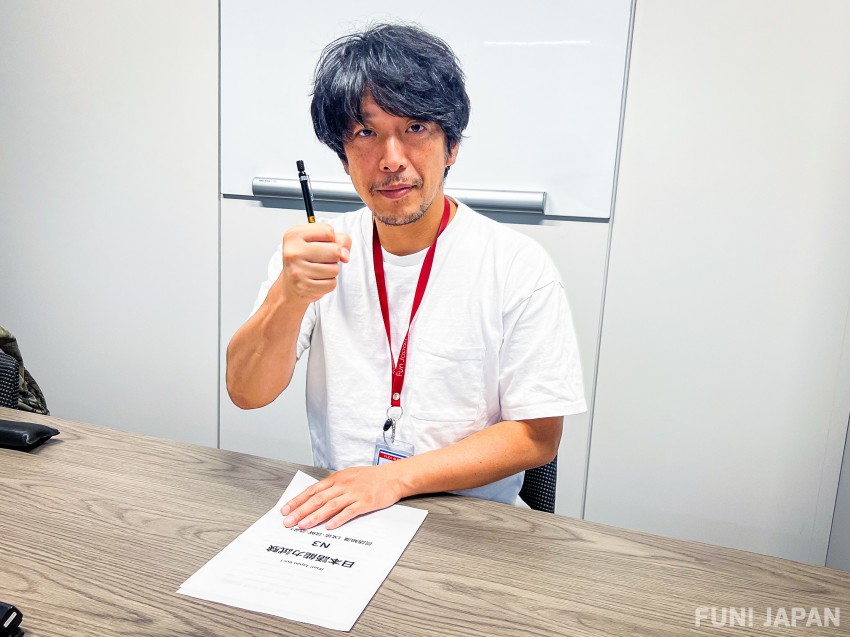
Just like the actual test, questions are given in various formats such as "Kanji Reading", "Notation", and "Usage".
"N3 level questions are about the level of third grade elementary school students in Japan. I get the feeling that the key points are something like the connection with the previous sentence and the use of particles.”
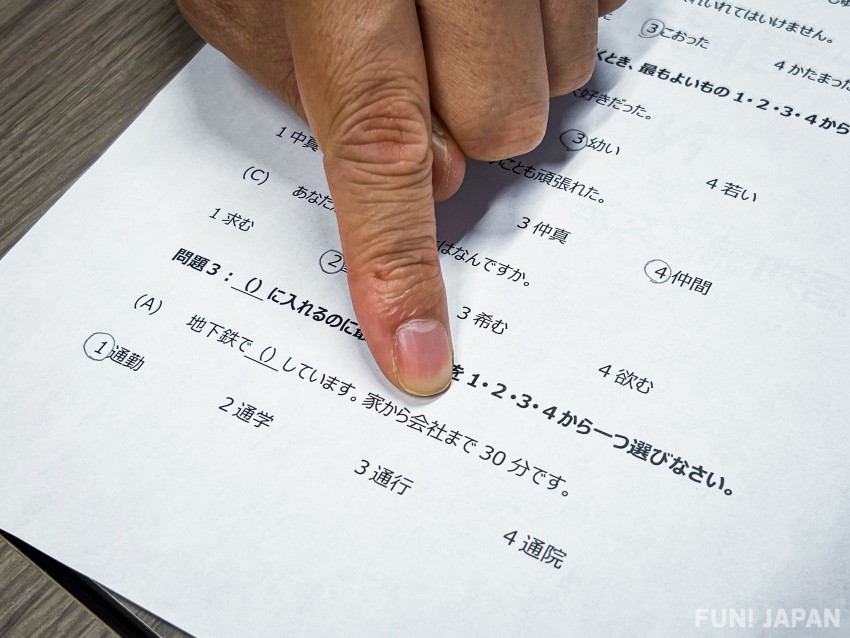
Sample question ① (N3 level)
| 地下鉄で()しています。家から会社まで30分です。-translation: I'm () on the subway. It takes 30 minutes from home to work.
- 通勤(つうきん)
- 通学(つうがく)
- 通行(つうこう)
- 通院(つういん)
"It's a tricky question with four similar kanji compounds, like the ones you see in textbooks in Japanese class. It's easy for beginners to make mistakes."
Question sample ② (N2 level)
| この場所は学校を建てるのにてきしている。-translation: This place is appropriate for building a school.
- 滴して
- 摘して
- 適して
- 敵して
“The problem that make me confused for a moment was this problem with 'appropriate' / 適 (てき)する. The kanji characters are very similar, so even Japanese people may make mistakes.”
"My advice to readers in countries that don't use kanji is to memorize the forms! Feel the meaning of the kanji!" (By the way, in order to pass N3, 600 kanji characters and 3,000 vocabulary words are a guideline, which is said to be about half of the 1,026 kanji characters learned in Japanese elementary schools.)
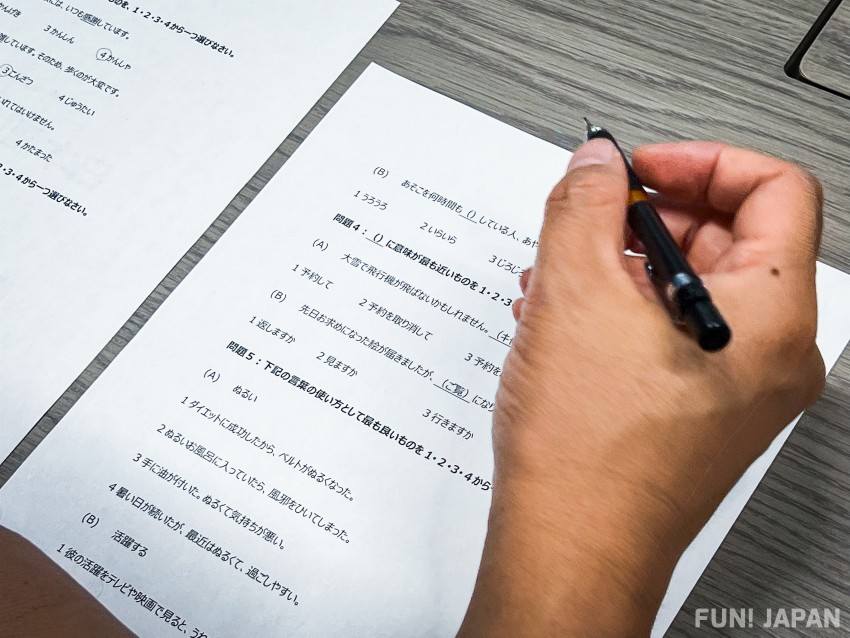
Sample question ③ (N3 level)
| 先日お求めになった絵が届きましたが、(ご覧)になりますか。-translation: The painting you asked for the other day has arrived. Would you like to take a look at it?
- 返しますか
- 見ますか
- 行きますか
- 確かめますか
Sample question ④ (N2 level)
| 事故で渋滞していた()ですから、到着が遅れてしまいました。申し訳ありません。-translation: I arrived late because I was stuck in traffic due to an accident. I am very sorry.
- こと
- ため
- だけ
- もの
"Compared to N3, N2 level is more difficult with the use of words and connecting sentences, but I think you will have many opportunities to use it in your daily life."
"I have the impression that no matter what you choose, it will all work as a sentence, so that is the difficult part. I think honorifics and humble words are especially difficult for beginners to understand." Although he said so, it seems that N3 and N2 levels were too easy for Japanese elite school graduate. Surprisingly, all the questions are correct so far!
Next is the most difficult level of JLPT: N1!
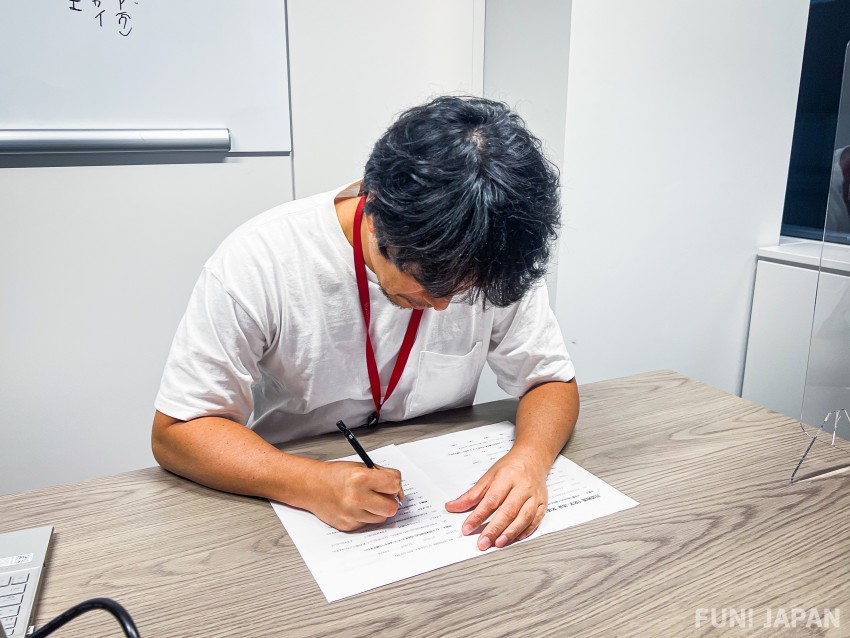
Next, let's get to the most difficult - N1 level. From here, in addition to 'Language Knowledge', 'Reading' is also a challenge. With the "last boss" that made many Japanese learners stumble put before his eyes, it's time to start the challenge with full concentration!
Sample question ⑤
| 私の人生を、人から()言われる筋合はない。-translation: There is no right for people to () about my life.
- とやかく
- とかく
- とにかく
- ともかく
Sample question ⑥
| 20年ぶりに同窓会で会った彼女は、あの頃よりもずっときれいになっていて、驚きを()。-translation: When I met her at the class reunion for the first time in 20 years, I () be surprised to see her so much prettier than back then.
- 足らないものだった
- 禁じ得なかった
- 余儀なくされた
- 堪えなかった
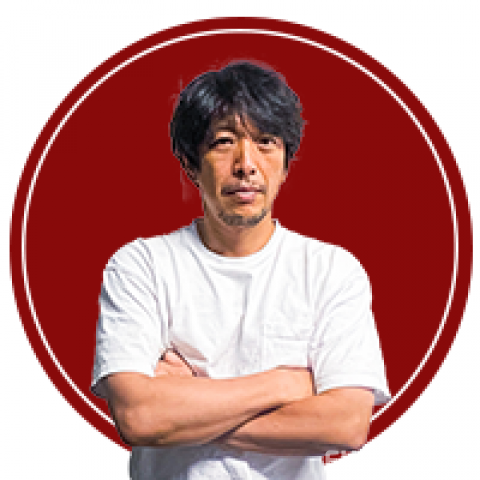
"There are a lot of expressions that Japanese don't usually use in daily life. I've never used 'toyakaku' (とやかく) in my life, and I heard 'I couldn't stop being surprised' (驚きを禁じえなかった) for the first time today. It's like reading a novel."
and then! Here comes the biggest challenge that troubles Rannyu Sensei who has continued to solve the sample questions so far with a smug face ―― a type in the form of "sentence construction" (select the best one that fits in ★, while the remain choices fit in the other ___).
Problem example ⑦
| 指揮者の父とピアニストの母の間に生まれた彼女は___ ___ ★ ___ あり。すばらしいヴァイオリン演奏に感動せずにはいられない。
-translation: Born between a conductor father and a pianist mother, she is ___ ___ ★ ___. I can't help but be moved by the wonderful violin performance.
- にして
- この子
- まさに
- この親

"I don't think you would normally say, 'この親にしてこの子あり' and you can also say 'この親にしてまさにこの子あり' too. It's an expression that you only hear in drama lines. (laughs)”
Problem example ⑧
| 首相の被災地での自分勝手な言動は、政治家として___ ★ ___ ___を得なかった。
-translation: The prime minister's selfish words and deeds in the disaster area, as a politician ___ ★ ___ ___.
- 大問題になって
- 辞任せざる
- 行為であって
- あるまじき

“If the order of these words changes, the meaning also changes too, so it’s confusing. Whether or not I got this one right depends on my luck eh? (laugh)"
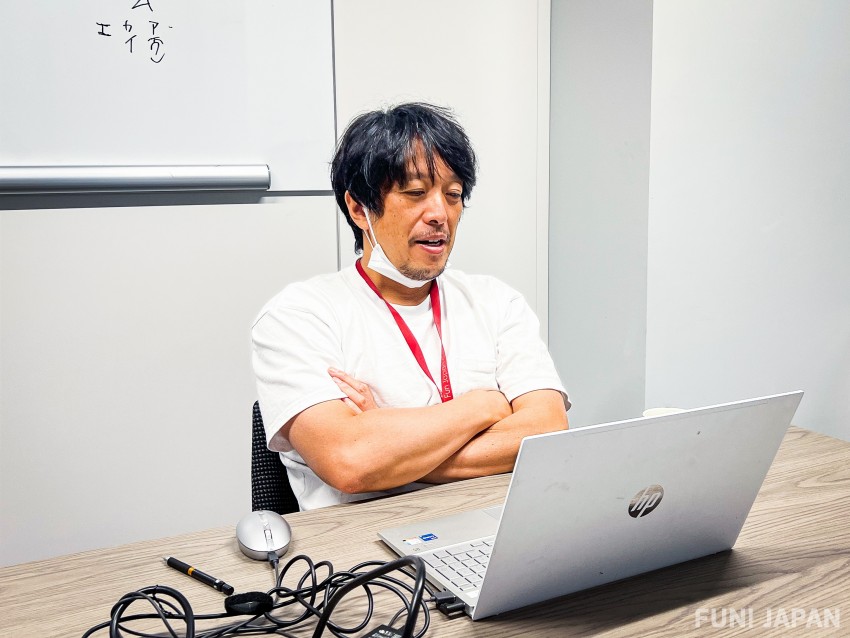
Beyond the mountain you're climbing, another awaits. Next, 'Listening' awaits our graduate from Japan's prestigious universitie.
Listen to a recording that is played only once and choose the answer that best describes the content from the choices. At first, he was confident with his arms crossed, but as he listened to the recording, his expression gradually darkened... (Unfortunately we can't show you the problem because it is in audio form)

“This is also quite difficult. They speak a little faster than most Japanese people, so I think even Japanese people will mishear. You have to take notes while listening, and if you can't listen well, it's easy to misunderstand and make mistakes."
Even a prestigious university graduate has this expression on his face. Even from a Japanese perspective, the N1 level seems difficult.
Postscript: What do Japanese people think about JLPT sample questions?
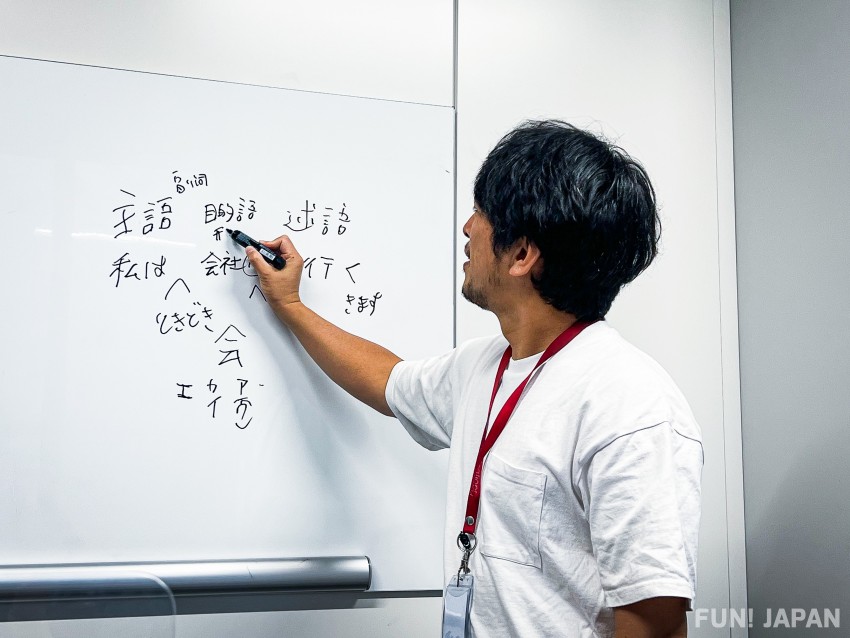
Rannyu Sensei put all his knowledge and faced this challenge. What are his thoughts on the challenge?
“Only Japanese people should take the JLPT exam (laughs). I thought that I should be aware of the order of Japanese words when talking to foreigners, and it was also an opportunity to review my Japanese.”
Rannyu Sensei once again realized the depth of the Japanese language. From this point on, he may even become a Japanese study fellow along with our readers!?
Here are the correct answers for the questions shown this time!
| Sample question | Correct answer | |
| ① | 地下鉄で()しています。家から会社まで30分です。 | 1. 通勤(つうきん) |
| ② | この場所は学校を建てるのにてきしている。 | 3. 適して |
| ③ | 先日お求めになった絵が届きましたが、(ご覧)になりますか。 | 2. 見ますか |
| ④ | 事故で渋滞していた()ですから、到着が遅れてしまいました。申し訳ありません。 | 4. もの |
| ⑤ | 私の人生を、人から()言われる筋合はない。 | 1. とやかく |
| ⑥ | 20年ぶりに同窓会で会った彼女は、あの頃よりもずっときれいになっていて、驚きを()。 | 2. 禁じ得なかった |
| ⑦ | 指揮者の父とピアニストの母の間に生まれた彼女は__ ___ ★ ___あり。すばらしいヴァイオリン演奏に感動せずにはいられない。 | 1. にして |
| ⑧ | 首相の被災地での自分勝手な言動は、政治家として___ ★ ___ ___を得なかった。 | 行為であって |
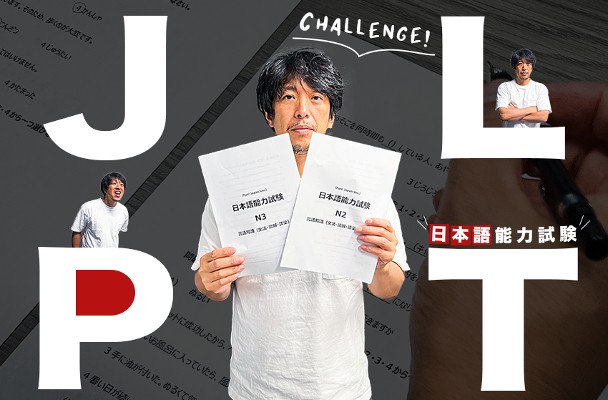
Comments